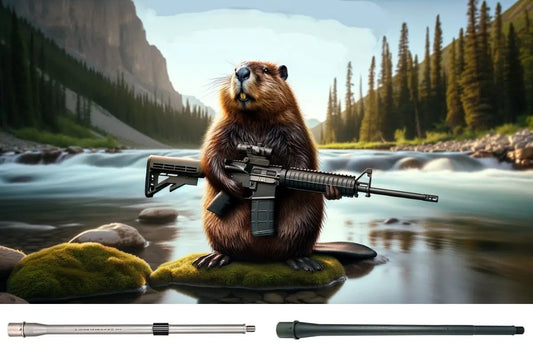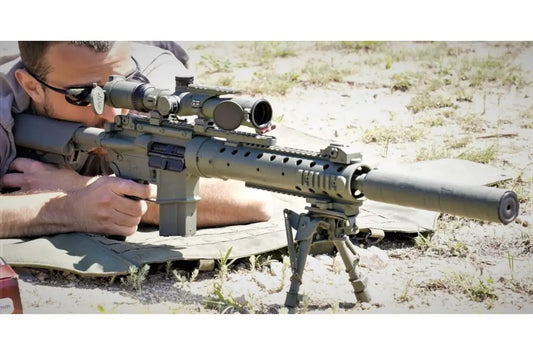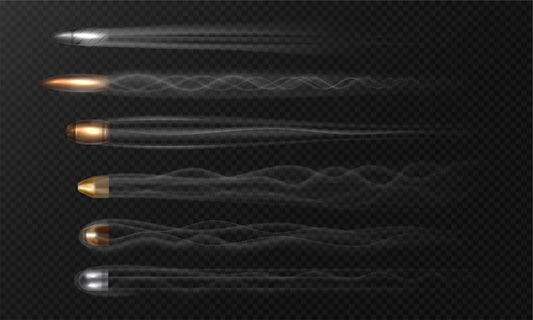
Defend Your Castle: A Layered, Expert Guide to Home Defense (2025 Edition)
TL;DR for Skimmers
- Build defense in layers: Deter → Detect → Delay → Defend → Document → Deal with the Aftermath.
- Best “first gun” for most: a quality 9mm handgun with a weapon light and defensive ammo (e.g., Glock 19 + Streamlight TLR-1 HL + Federal HST).
- Best long gun for home (if trained): 12-ga pump shotgun with 00 buck (preferably FLITECONTROL) or a soft-shooting AR-15 set up with a red dot and white light.
- Harden entry points (door reinforcement kits, window film), add smart alarms/cameras, practice a simple plan, and secure firearms in quick-access safes.
- Train more than you buy. As Jeff Cooper said, “Owning a handgun doesn’t make you armed …” — skill trumps gear.
Quick Summary Table: Layered Home Defense
|
Layer |
Purpose |
High-Quality Options |
Pros |
Cons |
|
Deter |
Make your home look hard to hit |
Door Armor MAX kit; 3M Safety & Security Film; Neighborhood Watch signage |
Inexpensive upgrades; always “on” |
Some install effort; doesn’t replace other layers |
|
Detect |
Know something’s wrong quickly |
Ring Alarm Pro; Arlo Pro 5S cams; UniFi G4 Doorbell Pro |
Fast alerts; video evidence |
Subscriptions/cloud dependence |
|
Delay |
Buy time to react |
StrikeMaster II Pro strike plate; reinforced hinges; smart locks |
Slows kick-ins; integrates with routines |
Requires proper install to be effective |
|
Defend |
Stop a threat if needed |
Glock 19 / SIG P320 (with TLR-1 HL or X300U); M&P15 Sport II or Ruger AR-556 (Aimpoint PRO + light); Mossberg 500 / Remington 870 + buckshot |
High reliability; adaptable |
Requires training; legal responsibilities |
|
Document |
Capture events for police/court |
Cameras, retained 911 recordings |
Supports your account; deters false claims |
Privacy tradeoffs |
|
Aftermath |
Survive legally & medically |
Self-defense legal membership; tourniquet + IFAK; “Stop the Bleed” class |
Covers legal/medical gaps |
Fees; must learn to use gear |
Why a Layered Plan Beats a “Gun-Only” Plan
Crime fluctuates, but property crime remains far more common than violent crime, and burglary trends have generally been declining — good news that doesn’t excuse complacency. Your goal is probability management: reduce the chance of a break-in, detect it fast, and keep control until help arrives. Think gates, guardrails, then guardians.
“Mission drives the gear train.” — Pat Rogers
Define your mission (home defense), then buy the minimum gear that accomplishes it well.
1) Deter & Harden: Make Your House a Bad Target
Doors & Windows (highest ROI)
- Door reinforcement:
- Armor Concepts Door Armor MAX—full jamb, hinge, and door-edge shields in a DIY kit. It massively strengthens the latch/strike area where kicks break doors.
- StrikeMaster II Pro—heavy strike-plate system that ties the door frame to the studs with long screws; fast installation.
- Pros: Big improvement for <$200/door; invisible once installed. Cons: Only as good as the install and the door/frame itself.
- Windows:
- 3M Scotchshield Ultra S600 safety/security film paired with the Impact Protection Attachment—helps hold glass together against impact and slows entry. Pros: Adds delay without changing aesthetics. Cons: Not a substitute for bars/laminate; professional install recommended.
Smart access
- August Wi-Fi Smart Lock (4th gen)—keeps your existing deadbolt & keys while adding remote control and logs. Pros: Easy retrofit. Cons: Battery & Wi-Fi dependence.
Community & CPTED (design away opportunity)
- Neighborhood Watch: Visibility and neighbor contact trees matter. Start or join one.
- CPTED principles (lighting, sightlines, territorial reinforcement) reduce opportunistic crime by design. Trim landscaping, light approaches, control access.
2) Detect Early: Alarms and Eyes
- Ring Alarm Pro Base Station (built-in eero Wi-Fi 6): A hub that ties sensors, cameras, and internet resilience together. Pros: Unified ecosystem; cellular backup options. Cons: Subscription for pro monitoring.
- Cameras that actually identify faces and plates:
- Arlo Pro 5S 2K (dual-band Wi-Fi, color night vision). Pros: Good image quality; flexible mounts. Cons: Cloud features cost.
- Ubiquiti UniFi G4 Doorbell Pro (for local NVR users): Robust doorbell with package cam and UniFi Protect integration. Pros: Local storage; pro-grade. Cons: Best if you already run UniFi.
Tip: Position one camera to read faces at the door and one to see vehicles at the street. Avoid sharing interior camera fields of view you wouldn’t want public.
3) Delay: Buy Time to Reach Cover & Call 911
Combine reinforced doors, window film, and long screws anchoring strikes/hinges into studs. A 5–10 second delay can be the difference between a barricade and a confrontation. Smart locks automate nightly lockups; set routines. (See products above.)
4) Defend: Firearms & Alternatives (with Specific, Proven Setups)
“Owning a handgun doesn’t make you armed any more than owning a guitar makes you a musician.” — Jeff Cooper. Training and setup matter more than brand decals. –buckeyefirearms.org
A. Handgun: Most people’s first defensive tool
Why: Maneuverable in hallways, one-handed use to manage kids/phones, fits quick-access safes.
Top picks (choose one, train hard):
- Glock 19 Gen5 (9mm): The industry’s baseline for reliability, size, and support; MOS option for optics. Capacity: 15+1.
- SIG Sauer P320 (9mm): Modular fire control unit, excellent triggers in many variants, broad grip/slide options.
Set it up right:
- Weapon light: You must be able to identify what you’re aiming at in the dark.
- Streamlight TLR-1 HL (1,000 lumens).
- SureFire X300U-B (1,000 lumens; bomb-proof). Pros: Elite durability. Cons: Price.
- Pistol red dots (optional but powerful):
- Holosun 507C X2 (shake-awake, solar fail-safe; RMR footprint).
- Trijicon RMR Type 2 (duty-grade durability).
- Defensive 9mm ammo:
- Federal HST 124gr, Speer Gold Dot 124gr, Hornady Critical Duty 135+P—all proven law-enforcement-grade loads. Pros: Consistent expansion/penetration. Cons: Cost vs ball ammo.
- Storage: Fort Knox PB1 (Simplex mechanical, 10-gauge steel) or a Vaultek biometric safe if you prefer electronic access. Pros: Quick access + secure from kids. Cons: Practice your open-and-present routine.
Pros: Maneuverable; easiest to secure; wide training/support.
Cons: Hardest to shoot well under stress; limited terminal performance vs long guns.
B. Shotgun: The room-distance hammer
Why: Devastating close-range performance with 00 buck; intuitive manual of arms with training.
Top picks:
- Mossberg 500 (12-ga): Proven pump platform with ambi-friendly tang safety; countless furniture/light options.
- Remington 870 Tactical (12-ga): Steel receiver, huge aftermarket; “Magpul” edition adds ergonomic furniture.
Ammo that patterns tight:
- Federal 00 Buck with FLITECONTROL—famously tight patterns that keep pellets on target. Pros: Accuracy advantage indoors. Cons: Availability can vary.
Pros: Enormous close-range effectiveness; simple manual; wide parts ecosystem.
Cons: Recoil management; slower reloads; overall length in tight spaces.
C. Carbine: Soft recoil, precision, and capacity
Why: Easier to shoot well than pistols; controllable; red dots shine indoors.
Top picks:
- Smith & Wesson M&P 15 Sport II: Reliable entry into AR-15s; optics-ready variants exist.
- Ruger AR-556: American-made AR with good out-of-box specs; multiple trims (MPR, etc.).
Set it up right:
- Red dot: Aimpoint PRO (2 MOA, years-long battery life, duty durability).
- White light: Streamlight TLR-1 HL-X (1,500/1,000 lumen multi-fuel) or a quality dedicated rifle light.
Pros: Easiest to place accurate shots quickly; low recoil; high capacity.
Cons: Length; over-penetration concerns are often overstated but still require backstop awareness and ammo selection/training.
D. Less-Lethal Complements (Layer, don’t replace)
- Oleoresin Capsicum (OC) / pepper gel for narrow hallways and less atomized blowback (e.g., SABRE Red). Pros: Option for unknowns (e.g., aggressive animal). Cons: Not a substitute for a firearm vs lethal threats.
- TASER Pulse/Pulse+: Conducted electrical weapon with distance; requires hits to work. Pros: More range than OC. Cons: Expensive consumables, clothing may defeat probes.
5) Document & Communicate
- Keep exterior cameras on doors/driveway and ensure your alarm calls/texts you. Retain recordings.
- When calling 911, keep it simple: location, nature of emergency, description (your clothing), and comply when officers arrive. (Your cameras and alarm logs will back your account later.)
6) Aftermath: Legal & Medical Preparedness
- Self-defense legal support (membership programs):
- USCCA Membership includes education, training, and self-defense liability insurance benefits for members. Pros: Education + hotline + coverage structure. Cons: Membership fees; policies vary by state.
-
Armed Citizens’ Legal Defense Network (now reported as acquired by CCW Safe): historically provided funding to member-selected attorneys after board review. Pros/Cons: Model differs from insurance; check current ownership/benefits.
Be sure to read the fine print and confirm your state’s rules. (News coverage notes the industry’s variability and scrutiny.) - Medical: Have a CAT Gen7 tourniquet and a compact IFAK accessible; take a Stop the Bleed class. Pros: Saves lives regardless of cause; training is short and inexpensive.
Training > Toys (The Part Most People Skip)
- Dry practice with purpose: A Mantis X10 Elite gives instant feedback on trigger press and movement. Add a SIRT pistol for safe reps. Pros: Objective metrics; reps without ammo. Cons: Up-front cost.
- Low-light reps with your weapon light matter. Practice safe light discipline and target identification (ID first, then decide).
- Hearing protection on the nightstand: Peltor Sport Tactical 500 or Sordin/MSA Supreme Pro-X electronic muffs let you hear/communicate while protecting hearing if a shot is fired indoors. Pros: Preserves situational awareness. Cons: Another step to don; keep them with the gun.
Putting It Together: Example Setups (Good → Better → Best)
Apartment / Smaller Home
- Deter/Delay: Door Armor on primary door; peephole cam or G4 Doorbell Pro if permitted; August Wi-Fi lock.
- Detect: Ring Alarm Pro + one Arlo cam on entry.
- Defend: Glock 19 with TLR-1 HL and HST, stored in Fort Knox PB1. Add Holosun 507C X2 once fundamentals are strong.
Pros: Compact, simple, highly effective. Cons: Handgun skill curve.
Suburban Home
- Add window film on accessible glass; two cameras (door + driveway).
- Defend: Keep the handgun above, and add a Mossberg 500 with Federal FLITECONTROL for the “barricade in place” plan.
Pros: Strong interior capability; visual documentation. Cons: Shotgun reload speed; practice required.
Rural Property
- Add perimeter detection and multiple cameras to cover approaches.
- Defend: Ruger AR-556 with Aimpoint PRO and a good rifle light; handgun as sidearm.
Pros: Precision and reach if distances open up. Cons: Training time; safe fields of fire.
Pros & Cons by Platform (Quick Hit)
Handgun
- Pros: Small, controllable with training, easiest to secure, can dial 911 with support hand.
-
Cons: Hardest to shoot under stress; modest terminal ballistics vs long guns.
Best-in-Class Add-ons: TLR-1 HL / X300U-B; RMR/507C.
Shotgun
- Pros: Shockingly effective inside a room; simple manual; ammo selection can reduce penetration compared to slugs.
-
Cons: Recoil; pattern/POI need testing; reloads slower.
Best-in-Class Ammo: Federal 00 Buck FLITECONTROL.
Carbine
- Pros: Soft recoil, fastest accurate fire, easiest to mount optics/light.
-
Cons: Size; training to run it safely indoors.
Best-in-Class Optic: Aimpoint PRO.
Reality Check: What Actually Moves the Needle
- Hardening (doors/windows) reduces the odds you’ll need a gun tonight.
- Detection buys time to get behind cover, gather family, and call for help.
- Training decides outcomes. Buy ammo and classes before your fourth accessory. (Cooper’s point stands.)
“The mission drives the gear train. Define your mission, then buy the best gear that fits it.” — Pat Rogers.
High-End, Meticulous Gear Picks (the “Japanese camera” tier)
- Pistol: Glock 19 Gen5 MOS or SIG P320 with Trijicon RMR Type 2 and SureFire X300U-B.
- Carbine: Ruger AR-556/S&W M&P15 + Aimpoint PRO + Streamlight TLR-1 HL-X rifle light.
- Shotgun: Remington 870 Tactical Magpul with Federal FLITECONTROL 00.
- Safe access: Fort Knox PB1 (mechanical Simplex) or Vaultek if you insist on biometrics.
- Alarm/cameras: Ring Alarm Pro, UniFi G4 Doorbell Pro (if on UniFi), or Arlo Pro 5S 2K.
- Hearing: MSA/Sordin Supreme Pro-X or Peltor Sport Tactical 500 at the nightstand.
Safety Notes (Non-Obvious but Crucial)
- Positive target ID at night is non-negotiable: mount a weapon light or hand a handheld light you can actually shoot with.
- Quick-access safe usage must be drilled (open → light → communicate → move to position). A safe you never practice with is a locked brick.
- Local law varies (castle doctrine/stand-your-ground/defensive display). Confirm your state’s statutes and consider a legal-support membership.
FAQ
Is burglary actually rising?
National UCR data show declines in 2023–2024 for many crimes, including burglary; your local risk still depends on neighborhood/behavior. Don’t plan on averages. –Federal Bureau of Investigation
What’s the best “first gun” for home defense?
For most: a quality 9mm handgun with a white light and duty-proven JHP. It’s the platform you’re most likely to secure and train with.
Is a shotgun “too much” inside the house?
With quality 00 buck, shotguns are extremely effective at room distances. Pattern your load and learn your holds.
Do cameras really help?
Yes. They deter, document, and speed arrests; doorbell cams with face-capture angles are worth it.
What about suppressors?
They can protect hearing and reduce blast indoors, but they’re NFA-regulated and not practical for many. If you go this route, ensure full legal compliance.
Final Checklist (Print-worthy)
- Harden doors/windows (Door Armor/StrikeMaster + 3M film).
- Install alarm + at least two cameras (entry + driveway).
- Choose one defensive platform and set it up right (light, quality ammo).
- Secure in a quick-access safe; practice opening.
- Build a simple family plan (rally point, call 911, verbal ID when police arrive).
- Take a low-light/home-defense class; add Stop the Bleed.
- Consider legal-support membership in your state.
Product References (Hand-Picked, Tier-One Quality)
- Handguns: Glock 19 Gen5 MOS; SIG P320 series.
- Lights: Streamlight TLR-1 HL/HL-X; SureFire X300U-B.
- Optics: Trijicon RMR Type 2; Holosun 507C X2; Aimpoint PRO (rifle).
- Rifles: S&W M&P15 Sport II; Ruger AR-556 family.
- Shotguns: Mossberg 500; Remington 870 Tactical.
- Ammo: Federal 00 FLITECONTROL.
- Safes: Fort Knox PB1; Vaultek quick-access options.
- Hardening: Door Armor MAX; StrikeMaster II Pro; 3M Ultra S600 film.
- Sensors/Cameras: Ring Alarm Pro; Arlo Pro 5S 2K; UniFi G4 Doorbell Pro.
- Medical: CAT Gen7 tourniquet; NAR IFAK; Stop the Bleed.
- Hearing: MSA/Sordin Supreme Pro-X; Peltor Tactical 500.
The Take
If you want the best, buy less gear and train more. Start with hardening, add detection, then select one defensive platform and master it. Your plan’s simplicity is a feature, not a bug. Equipment is there to enable decision-making under stress, not replace it.
Pat Rogers: “Mission drives the gear train.”
Jeff Cooper: “Owning a handgun doesn’t make you armed …”
Memorize those, and you’ll avoid 90% of the bad advice out there.
Visit SCHEELS.com to shop for home defense firearms & ammunition.




